Zixuan Huang
Semantic Radio Access Networks: Architecture, State-of-the-Art, and Future Directions
Dec 24, 2025Abstract:Radio Access Network (RAN) is a bridge between user devices and the core network in mobile communication systems, responsible for the transmission and reception of wireless signals and air interface management. In recent years, Semantic Communication (SemCom) has represented a transformative communication paradigm that prioritizes meaning-level transmission over conventional bit-level delivery, thus providing improved spectrum efficiency, anti-interference ability in complex environments, flexible resource allocation, and enhanced user experience for RAN. However, there is still a lack of comprehensive reviews on the integration of SemCom into RAN. Motivated by this, we systematically explore recent advancements in Semantic RAN (SemRAN). We begin by introducing the fundamentals of RAN and SemCom, identifying the limitations of conventional RAN, and outlining the overall architecture of SemRAN. Subsequently, we review representative techniques of SemRAN across physical layer, data link layer, network layer, and security plane. Furthermore, we envision future services and applications enabled by SemRAN, alongside its current standardization progress. Finally, we conclude by identifying critical research challenges and outlining forward-looking directions to guide subsequent investigations in this burgeoning field.
How Much 3D Do Video Foundation Models Encode?
Dec 23, 2025Abstract:Videos are continuous 2D projections of 3D worlds. After training on large video data, will global 3D understanding naturally emerge? We study this by quantifying the 3D understanding of existing Video Foundation Models (VidFMs) pretrained on vast video data. We propose the first model-agnostic framework that measures the 3D awareness of various VidFMs by estimating multiple 3D properties from their features via shallow read-outs. Our study presents meaningful findings regarding the 3D awareness of VidFMs on multiple axes. In particular, we show that state-of-the-art video generation models exhibit a strong understanding of 3D objects and scenes, despite not being trained on any 3D data. Such understanding can even surpass that of large expert models specifically trained for 3D tasks. Our findings, together with the 3D benchmarking of major VidFMs, provide valuable observations for building scalable 3D models.
Design of A Low-Latency and Parallelizable SVD Dataflow Architecture on FPGA
Nov 18, 2025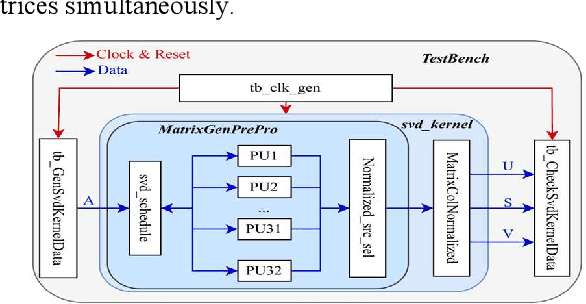
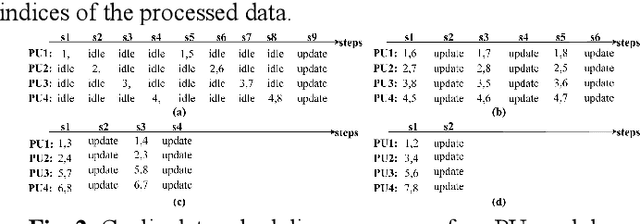
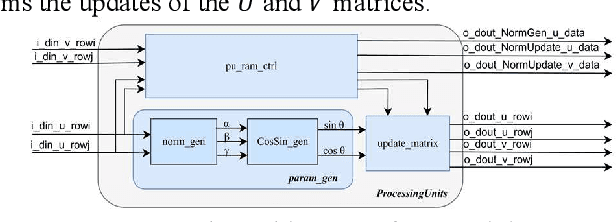
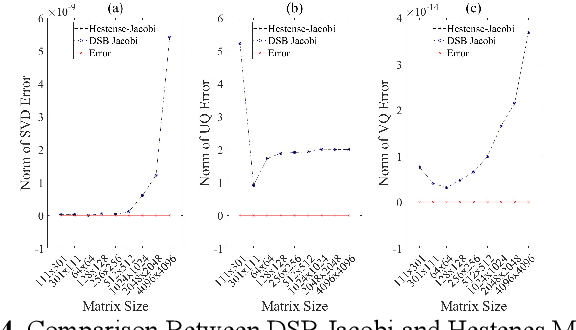
Abstract:Singular value decomposition (SVD) is widely used for dimensionality reduction and noise suppression, and it plays a pivotal role in numerous scientific and engineering applications. As the dimensions of the matrix grow rapidly, the computational cost increases significantly, posing a serious challenge to the efficiency of data analysis and signal processing systems,especially in time-sensitive scenarios with large-scale datasets. Although various dedicated hardware architectures have been proposed to accelerate the computation of intensive SVD, many of these designs suffer from limited scalability and high consumption of on-chip memory resources. Moreover, they typically overlook the computational and data transfer challenges associated with SVD, enabling them unsuitable for real-time processing of large-scale data stream matrices in embedded systems. In this express, we propose a Data Stream-Based SVD processing algorithm (DSB Jacobi), which significantly reduces on-chip BRAM usage while improving computational speed, offering a practical solution for real-time SVD computation of large-scale data streams. Compared with previous works, our experimental results indicate that the proposed method reduces on-chip RAM consumption by 41.5 percent and improves computational efficiency by 23 times.
Unified Multimodal Diffusion Forcing for Forceful Manipulation
Nov 06, 2025Abstract:Given a dataset of expert trajectories, standard imitation learning approaches typically learn a direct mapping from observations (e.g., RGB images) to actions. However, such methods often overlook the rich interplay between different modalities, i.e., sensory inputs, actions, and rewards, which is crucial for modeling robot behavior and understanding task outcomes. In this work, we propose Multimodal Diffusion Forcing, a unified framework for learning from multimodal robot trajectories that extends beyond action generation. Rather than modeling a fixed distribution, MDF applies random partial masking and trains a diffusion model to reconstruct the trajectory. This training objective encourages the model to learn temporal and cross-modal dependencies, such as predicting the effects of actions on force signals or inferring states from partial observations. We evaluate MDF on contact-rich, forceful manipulation tasks in simulated and real-world environments. Our results show that MDF not only delivers versatile functionalities, but also achieves strong performance, and robustness under noisy observations. More visualizations can be found on our website https://unified-df.github.io
AnoF-Diff: One-Step Diffusion-Based Anomaly Detection for Forceful Tool Use
Sep 18, 2025Abstract:Multivariate time-series anomaly detection, which is critical for identifying unexpected events, has been explored in the field of machine learning for several decades. However, directly applying these methods to data from forceful tool use tasks is challenging because streaming sensor data in the real world tends to be inherently noisy, exhibits non-stationary behavior, and varies across different tasks and tools. To address these challenges, we propose a method, AnoF-Diff, based on the diffusion model to extract force-torque features from time-series data and use force-torque features to detect anomalies. We compare our method with other state-of-the-art methods in terms of F1-score and Area Under the Receiver Operating Characteristic curve (AUROC) on four forceful tool-use tasks, demonstrating that our method has better performance and is more robust to a noisy dataset. We also propose the method of parallel anomaly score evaluation based on one-step diffusion and demonstrate how our method can be used for online anomaly detection in several forceful tool use experiments.
Planning-Query-Guided Model Generation for Model-Based Deformable Object Manipulation
Aug 26, 2025Abstract:Efficient planning in high-dimensional spaces, such as those involving deformable objects, requires computationally tractable yet sufficiently expressive dynamics models. This paper introduces a method that automatically generates task-specific, spatially adaptive dynamics models by learning which regions of the object require high-resolution modeling to achieve good task performance for a given planning query. Task performance depends on the complex interplay between the dynamics model, world dynamics, control, and task requirements. Our proposed diffusion-based model generator predicts per-region model resolutions based on start and goal pointclouds that define the planning query. To efficiently collect the data for learning this mapping, a two-stage process optimizes resolution using predictive dynamics as a prior before directly optimizing using closed-loop performance. On a tree-manipulation task, our method doubles planning speed with only a small decrease in task performance over using a full-resolution model. This approach informs a path towards using previous planning and control data to generate computationally efficient yet sufficiently expressive dynamics models for new tasks.
MEBench: A Novel Benchmark for Understanding Mutual Exclusivity Bias in Vision-Language Models
May 26, 2025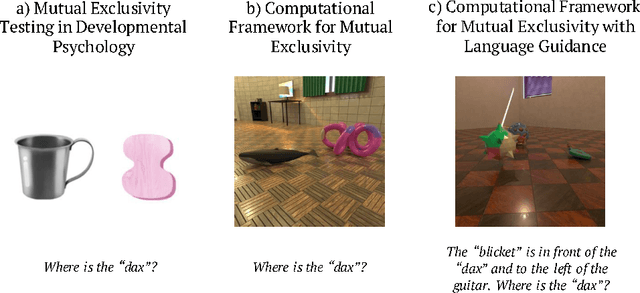



Abstract:This paper introduces MEBench, a novel benchmark for evaluating mutual exclusivity (ME) bias, a cognitive phenomenon observed in children during word learning. Unlike traditional ME tasks, MEBench further incorporates spatial reasoning to create more challenging and realistic evaluation settings. We assess the performance of state-of-the-art vision-language models (VLMs) on this benchmark using novel evaluation metrics that capture key aspects of ME-based reasoning. To facilitate controlled experimentation, we also present a flexible and scalable data generation pipeline that supports the construction of diverse annotated scenes.
An ACO-MPC Framework for Energy-Efficient and Collision-Free Path Planning in Autonomous Maritime Navigation
Apr 22, 2025Abstract:Automated driving on ramps presents significant challenges due to the need to balance both safety and efficiency during lane changes. This paper proposes an integrated planner for automated vehicles (AVs) on ramps, utilizing an unsatisfactory level metric for efficiency and arrow-cluster-based sampling for safety. The planner identifies optimal times for the AV to change lanes, taking into account the vehicle's velocity as a key factor in efficiency. Additionally, the integrated planner employs arrow-cluster-based sampling to evaluate collision risks and select an optimal lane-changing curve. Extensive simulations were conducted in a ramp scenario to verify the planner's efficient and safe performance. The results demonstrate that the proposed planner can effectively select an appropriate lane-changing time point and a safe lane-changing curve for AVs, without incurring any collisions during the maneuver.
SPAR3D: Stable Point-Aware Reconstruction of 3D Objects from Single Images
Jan 08, 2025



Abstract:We study the problem of single-image 3D object reconstruction. Recent works have diverged into two directions: regression-based modeling and generative modeling. Regression methods efficiently infer visible surfaces, but struggle with occluded regions. Generative methods handle uncertain regions better by modeling distributions, but are computationally expensive and the generation is often misaligned with visible surfaces. In this paper, we present SPAR3D, a novel two-stage approach aiming to take the best of both directions. The first stage of SPAR3D generates sparse 3D point clouds using a lightweight point diffusion model, which has a fast sampling speed. The second stage uses both the sampled point cloud and the input image to create highly detailed meshes. Our two-stage design enables probabilistic modeling of the ill-posed single-image 3D task while maintaining high computational efficiency and great output fidelity. Using point clouds as an intermediate representation further allows for interactive user edits. Evaluated on diverse datasets, SPAR3D demonstrates superior performance over previous state-of-the-art methods, at an inference speed of 0.7 seconds. Project page with code and model: https://spar3d.github.io
Symmetry Strikes Back: From Single-Image Symmetry Detection to 3D Generation
Nov 26, 2024
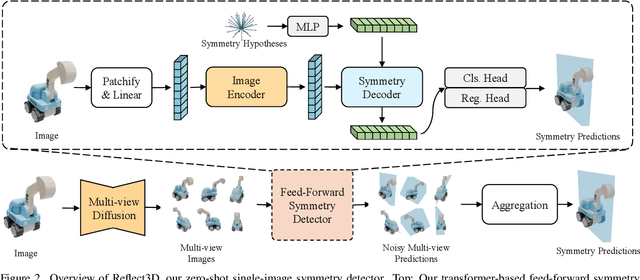


Abstract:Symmetry is a ubiquitous and fundamental property in the visual world, serving as a critical cue for perception and structure interpretation. This paper investigates the detection of 3D reflection symmetry from a single RGB image, and reveals its significant benefit on single-image 3D generation. We introduce Reflect3D, a scalable, zero-shot symmetry detector capable of robust generalization to diverse and real-world scenarios. Inspired by the success of foundation models, our method scales up symmetry detection with a transformer-based architecture. We also leverage generative priors from multi-view diffusion models to address the inherent ambiguity in single-view symmetry detection. Extensive evaluations on various data sources demonstrate that Reflect3D establishes a new state-of-the-art in single-image symmetry detection. Furthermore, we show the practical benefit of incorporating detected symmetry into single-image 3D generation pipelines through a symmetry-aware optimization process. The integration of symmetry significantly enhances the structural accuracy, cohesiveness, and visual fidelity of the reconstructed 3D geometry and textures, advancing the capabilities of 3D content creation.
 Add to Chrome
Add to Chrome Add to Firefox
Add to Firefox Add to Edge
Add to Edge